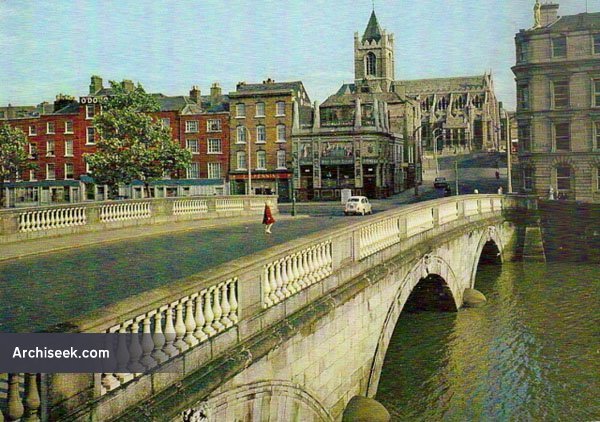1870 – The Irish House, Nos.1-2 Wood Quay, Dublin

The Irish House was built in 1870 at the corner of Winetavern Street and Wood Quay in Dublin, and became a popular public house and well-known piece of Celtic Revival architecture. The Irish House featured an external stucco frieze, by local stuccodores Burnet and Comerford, of various figures from mythology and the history of Irish constitutional nationalism. The facade featured a figure of Eireann weeping forlorn upon her stringless harp, Daniel O’Connell stood clutching the Catholic Emancipation Act of 1829, Henry Grattan and a seventeen figure frieze depicting the Act of Union of 1800, all surmounted by a collection of monastic round towers.
The facade, popular with the public, was less so with the architectural press. The Irish Builder in June 1870 stuck the boot in: “the genius who designed the unsightly structure now in process of erection at the corner of Winetavern Street on the quays (which we understand is intended as a gin palace), having no scope in the sub-structure, directed his entire attention to the super. We were for a considerable time puzzled to discover what its skyline was intended to represent, but plasterers have been busily engaged up it for the past few weeks, and they have brought into view, by plentiful application of Portland cement, six ludicrous imitations of round towers perched upon its parapet.”
“There are few public establishments so strongly connected with natural historic associations as the “Irish House,” which is situated on Wood Quay. This is one of the oldest establishments of its line known to exist in our populous city. Associated with memories of patriots, the remembrances of whose troublous times are embodied in the pictorial emblems adorning the exterior, one of the most parliament is that representing “Grattan’s last appeal in the Irish Mouse of Commons before the passing of the Union” another denotes O’Connell upholding the Emancipation Act in the Irish House of Commons in 1826. Erin weeping at the loss of her parliament is an illustration that calls to remembrance that short lived but illustrious House of Commons on College Green ; Irish emblems representing the “Four Provinces” are also emblazoned on the exterior, with representations of the utensils use I for drinking by the ancient Irish.
The interior walls are decorated with beautiful oil-paintings of the renowned Vale of Avoca, and the historic and picturesque Lakes of Killarney. Over the counter stands a figure representing Erin, in one hand she grasps a sword, the other unfolds to the breeze the banner of our native land ; a clock that points the time is encased in a harp of Irish oak-work surmounted by a cross, and the battle-axes and spears in use in Ireland from the days of King Dathi down to ’82. This establishment is considered and looked upon as the most historic house in the most historic ward in Dublin, O’Connell being the first Catholic that ever entered the “Old Corporation,” which w.as about the year 1S20. The ground on which the present building stands forms a portion of the St. Patrick division for representation in Parliament. Mr. Patrick O’Kelly, the energetic proprietor of the ” Irish House,” is well known for the courteous manner in which he conducts his business, and it is to be trusted that he will long continue in the eminent position which lie at present holds. He is an elected P. L. G. for Wood Quay Ward at the Board of the South Dublin Union, and through his remarkable ability and popularity there is no constituency in Dublin that would not feel honoured by his representation. “
The Industries of Dublin, S. Blackett, 1887
The pub was bought through compulsory purchase in 1968 and was demolished to make way for the new Dublin Corporation Civic Offices. Before demolition, the majority of the friezes were removed and put into storage at Guinness, where they remained for many years. Now in the possession of Dublin Civic Trust, they are periodically displayed.
Published March 11, 2013 | Last Updated June 16, 2025





